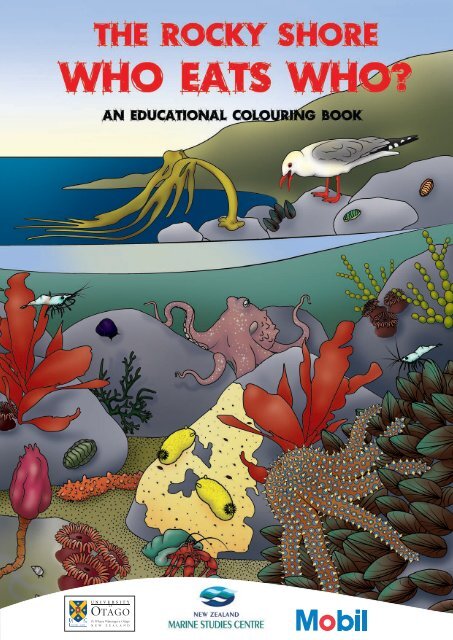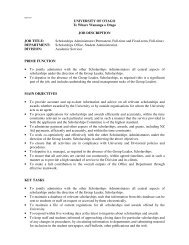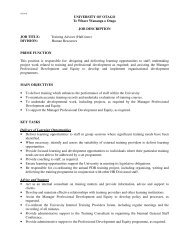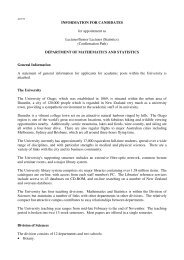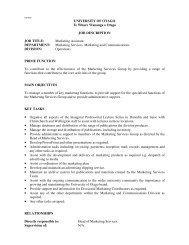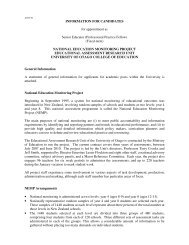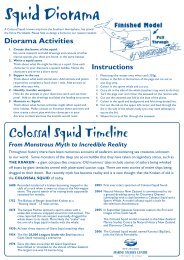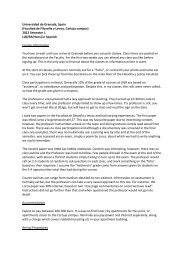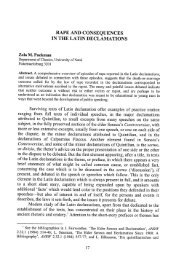Rocky Shore Who Eats Who Colouring Book - University of Otago
Rocky Shore Who Eats Who Colouring Book - University of Otago
Rocky Shore Who Eats Who Colouring Book - University of Otago
Create successful ePaper yourself
Turn your PDF publications into a flip-book with our unique Google optimized e-Paper software.
CREATURES OF THE NZ ROCKY SHORE<br />
This educational colouring book was<br />
conceived by staff at the New Zealand<br />
Marine Studies Centre and illustrated by<br />
Corlis Schneider.<br />
© New Zealand Marine Studies Centre 2012<br />
Information for Teachers and Parents. This educational colouring book features the animals and plants found<br />
between the tides on New Zealand’s rocky shores and in shallow coastal waters. The illustrations show diet, feeding<br />
strategies, adaptations to find and capture food and avoid predators. Children should be encouraged to interpret<br />
what is happening in the scenes and predict what might happen next. Further information about a selection <strong>of</strong><br />
the creatures can be found at the end <strong>of</strong> this book. Creating a food web will highlight the role <strong>of</strong> these creatures<br />
in the ocean environment. Further discussion topics include factors that could change their food web or affect the<br />
animals’ ability to find or catch their dinner. Children could then make a poster to illustrate their ideas <strong>of</strong> what they<br />
could do to look after this unique environment.<br />
The illustrations in this book may be copied for educational purposes.<br />
Mobil Oil New Zealand Limited provides funds for community projects in areas<br />
where it operates and has been supporting the New Zealand Marine Studies<br />
Centre to develop and promote marine education resources since 2008. Mobil<br />
has supported a range <strong>of</strong> <strong>Rocky</strong> <strong>Shore</strong> publications, including the Northern and<br />
Southern New Zealand <strong>Rocky</strong> <strong>Shore</strong> Guides, the <strong>Rocky</strong> <strong>Shore</strong> Activities <strong>Book</strong>,<br />
and now The <strong>Rocky</strong> <strong>Shore</strong> <strong>Who</strong> <strong>Eats</strong> <strong>Who</strong> Educational <strong>Colouring</strong> <strong>Book</strong>. These<br />
publications, which aim to promote awareness <strong>of</strong> seashore marine plants and<br />
creatures, are useful resources for schools, environmental/coastal groups and<br />
families.<br />
Further information about Mobil’s operations and community programmes is<br />
available at www.mobil.co.nz<br />
The New Zealand Marine Studies Centre and Aquarium,<br />
part <strong>of</strong> the <strong>University</strong> <strong>of</strong> <strong>Otago</strong>’s Department <strong>of</strong> Marine<br />
Science, showcases marine life from southern NZ waters<br />
and provides expert knowledge and education about New Zealand’s marine environment.<br />
The educational programmes involve students in the excitement <strong>of</strong> scientific discovery,<br />
help them develop knowledge and skills, and encourage individuals to take responsibility<br />
and action for the future <strong>of</strong> our ocean resource. Contact the NZ Marine Studies Centre for<br />
further information about the range <strong>of</strong> educational programmes and resources available<br />
for schools and interest groups.<br />
VISIT DUNEDIN’S BOUTIQUE AQUARIUM<br />
See the creatures illustrated<br />
in this book, and much more.<br />
Open every day 10am - 4.30pm<br />
Call (03) 479 5826<br />
Email marine-studies@otago.ac.nz<br />
Visit www.marine.ac.nz
NEW ZEALAND’s<br />
rocky shore<br />
who eats who?<br />
Printed on 100% recycled paper.<br />
Discover the creatures that live<br />
between the tides on the rocky<br />
shore and in the shallow coastal<br />
waters <strong>of</strong> New Zealand.<br />
Colour the pictures and gather<br />
clues about what they eat, how<br />
they catch their food and avoid<br />
their predators.<br />
Create a food web to understand<br />
the importance <strong>of</strong> these plants<br />
and animals in the ocean<br />
environment.<br />
www.marine.ac.nz
www.marine.ac.nz<br />
plankton SOUP<br />
Tiny PRODUCERS (phytoplankton) and animals (zooplankton) form the<br />
base <strong>of</strong> the food chain in the ocean. Sea creatures have food all around<br />
them, but how do they catch it?
FILTER FEEDERS<br />
www.marine.ac.nz<br />
Barnacles have tiny feet that they kick out to trap and filter<br />
plankton. Sea tulips suck water into one opening, pass it through<br />
a sieve to filter out the plankton and then push the water out <strong>of</strong><br />
another opening.
www.marine.ac.nz<br />
SEAWEEDs<br />
Seaweeds are PRODUCERS. They use the<br />
sun’s energy to grow and provide food<br />
for many marine animals like kina. Some<br />
seaweeds are green but others are brown<br />
or red.
GRAZERS<br />
www.marine.ac.nz<br />
Grazers are the vegetarians <strong>of</strong> the rocky shore. Can you find the<br />
black duck’s bill limpet, paua, chitons, limpets, periwinkles and<br />
top snails in this picture? They scrape seaweed <strong>of</strong>f the rocks<br />
with their long zipper-like tongues.
www.marine.ac.nz<br />
SCAVENGERS<br />
These rubbish collectors - or recyclers - play an important role in the<br />
sea. Hermit crabs, sea anemones, sea cucumbers, shrimp and some<br />
sea stars eat the dead plants and animals left on the ocean floor.
ARMED PREDATORS<br />
The hungry octopus hunts for a crab by delicately<br />
feeling over sand and rocks with its arms. How does a<br />
crab avoid being eaten?<br />
www.marine.ac.nz
www.marine.ac.nz<br />
Every time you visit the rocky<br />
shore you discover something<br />
new!<br />
How many creatures can you<br />
find in the picture?
Anemones<br />
Chitons<br />
Crabs<br />
Gulls<br />
Nudibranchs<br />
Octopus<br />
Sea Stars<br />
Sea Tulips<br />
Shrimps<br />
Snails<br />
www.marine.ac.nz
www.marine.ac.nz<br />
FISHY PREDATORS<br />
You might eat blue cod for your tea, but what does<br />
the blue cod like to eat? Crabs are a favourite. How is<br />
the crab in this picture hiding?
PREDATORS WITH TEETH<br />
Carpet sharks are found in rocky areas near the shore.<br />
They are looking for crustaceans and molluscs.<br />
www.marine.ac.nz
www.marine.ac.nz<br />
VISITING PREDATORS<br />
Gulls like fresh shellfish but find it difficult to get into<br />
the closed shell. How do they break the shell so they<br />
can eat the mussel?
HUMAN GATHERERS<br />
What seafood do YOU like to eat?<br />
When you gather seafood, make sure you follow the<br />
fishing guidelines and leave enough<br />
for the other creatures!<br />
www.marine.ac.nz
www.marine.ac.nz<br />
FOOD WEB<br />
predator<br />
predator predator<br />
filter feeder<br />
filter feeder<br />
producer<br />
scavenger<br />
dead plants<br />
and animals
www.marine.ac.nz<br />
make your own FOOD WEB<br />
You can include:<br />
producers, grazers,<br />
scavengers, predators<br />
and filter feeders.<br />
producer
www.marine.ac.nz<br />
Creature Key<br />
Phytoplankton are single-celled organisms that use the sun’s energy to make their<br />
own food by the process <strong>of</strong> photosynthesis. They are free-floating and are eaten by<br />
zooplankton and filter feeders.<br />
Seaweeds are the plants <strong>of</strong> the sea. They use photosynthesis to make their own<br />
food. Some are tiny and encrust rocks. Others grow to lengths <strong>of</strong> 50 metres and form<br />
underwater forests. Many animals feed on seaweeds.<br />
Crabs such as the half crab, are filter feeders. They use nets to filter plankton from<br />
the surrounding water. Their large claws are used for defence, not feeding.<br />
<strong>Shore</strong> crabs are scavengers. They use their claws to tear dead plants and animals into<br />
small bite-sized pieces.<br />
Barnacles are related to crabs and lobsters but are glued to the rock surface, so<br />
chasing their food is not an option. They use their feathery legs to filter plankton<br />
from the water around them.<br />
Limpets have a cone shaped shell and a muscular foot for holding onto rocks. They<br />
are grazers. They have a long zipper-like tongue called a radula that they use to<br />
scrape seaweed <strong>of</strong>f rocks. They move around to graze, but return to a favourite spot<br />
to rest.<br />
Chitons have eight separate shell plates and a muscular foot to hold onto rocks.<br />
Chitons graze on seaweed using their rasping radula. The teeth on their radula<br />
are made <strong>of</strong> iron so they don’t wear away when scraping seaweed <strong>of</strong>f rocks. Look<br />
carefully for their feeding trails.<br />
The sea tulip looks like a plant, but it is an animal - a filter-feeding sea squirt.<br />
Although sea tulips cannot move, their long stalks allow them to reach plankton-rich<br />
water.
www.marine.ac.nz<br />
Sea stars come in many shapes and sizes and usually have five arms. The biscuit sea<br />
star is a scavenger, scouring the ocean floor for food. Sea stars push their stomachs<br />
outside their bodies to absorb their food.<br />
Predatory sea stars, like the spiny sea star, use their tube feet to slowly pull apart<br />
mussels and other shellfish. They squeeze their stomachs between the two shells and<br />
begin to digest the mussel inside. These sea stars may have up to eleven arms.<br />
Nudibranchs are predators. They feed on sponges which encrust rocks. Some<br />
nudibranchs take on the colour <strong>of</strong> the sponges they eat. They breathe through<br />
feathery gills on the outside <strong>of</strong> their bodies.<br />
Anemones are predators. They trap passing prey with their stinging tentacles, pulling<br />
it into their stomach to digest. They will also scavenge any food that comes their way.<br />
Shrimps scavenge for their food. The glass shrimp is difficult to spot in tide pools<br />
because it has a mostly transparent body.<br />
Rock pool fish, such as the olive rock fish, hunt for small crustaceans in tidepools<br />
and along the shore. They hide under rocks at low tide so they don’t get carried into<br />
deeper water where bigger fish might eat them.<br />
Octopus are predators. The mouth <strong>of</strong> an octopus looks like the beak <strong>of</strong> a parrot. It<br />
uses its beak to crack the hard shells <strong>of</strong> crustaceans. The ability <strong>of</strong> octopus to change<br />
colour allows them to surprise their prey and hide from other predators.<br />
Sharks will take live prey or scavenge for dead animals. The carpet shark has tiny<br />
teeth and eats small crustaceans and molluscs. The largest fish in the ocean is a<br />
whale shark which is a filter feeder.<br />
Gulls eat many kinds <strong>of</strong> live and dead creatures they find on the shore. When they<br />
find a mussel or snail, they carry it into the sky and drop it onto the rocks from a<br />
height to break the shell open.


